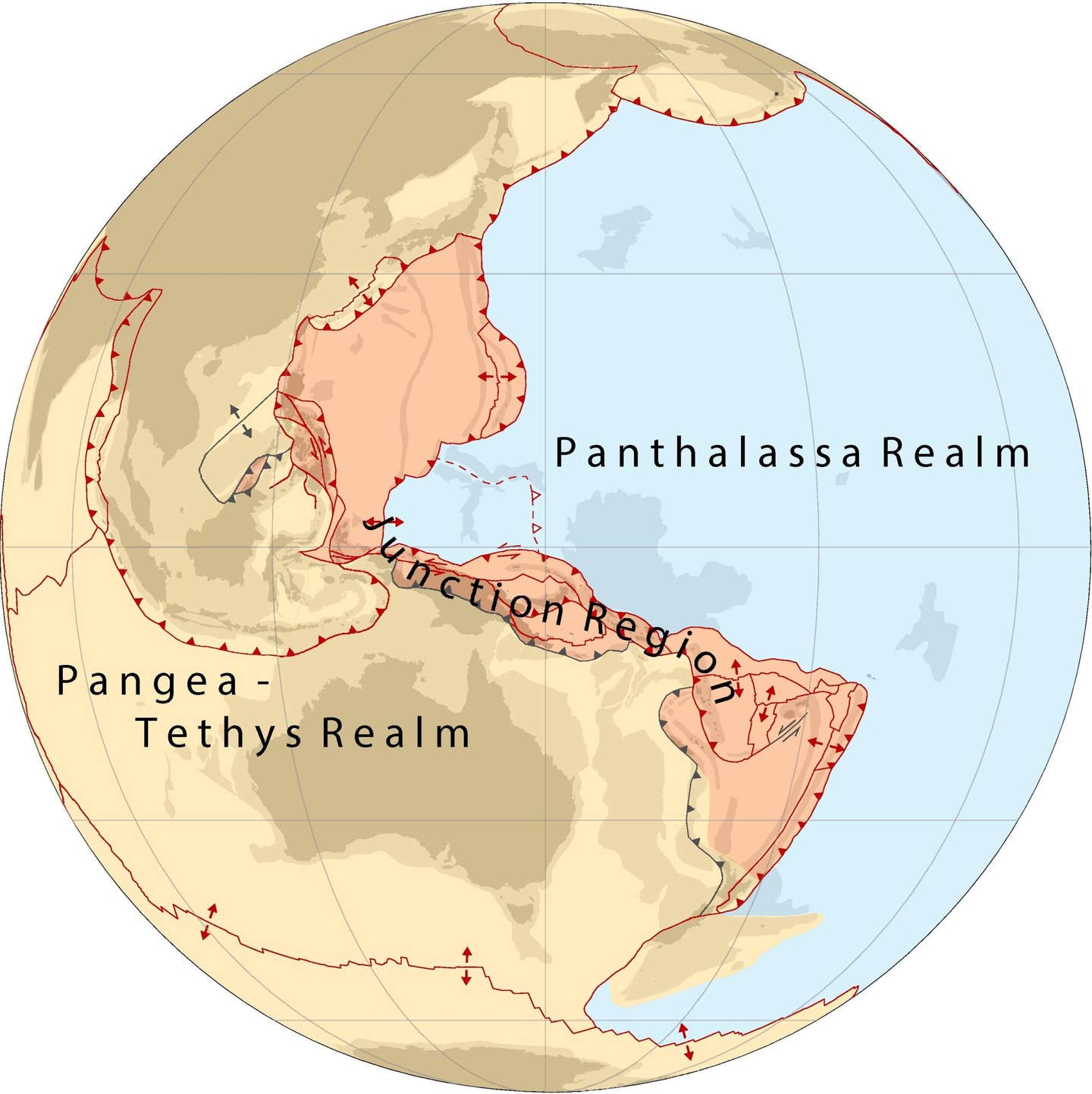Lost Pacific tectonic plate named Pontus found after 160 million years
In one of Earth’s most tectonically complex areas—stretching from Japan to New Zealand—geologists have uncovered what many thought was gone forever.

Map of the Pangea-Tethys and Panthalassa plate tectonic realms separated by the Juction Region. Present-day plate boundaries are red. (CREDIT: ScienceDirect)
Far beneath the ocean's surface, where mountain belts rise and ancient oceanic crust lies hidden, a long-lost tectonic plate has been brought back into view. In one of Earth's most tectonically complex areas—stretching from Japan to New Zealand—geologists have uncovered what many thought was gone forever.
Thanks to years of fieldwork, seismic data, and computer models, a massive tectonic plate once buried beneath the western Pacific has reemerged. It's called Pontus, and it once spanned one-quarter of the Pacific Ocean.
Rediscovering a Giant of the Past
Pontus first made its quiet return from geological oblivion through subtle hints. Seismic waves traveling through Earth’s mantle sometimes move in strange ways, especially when they pass through temperature or composition anomalies deep underground. These distortions, often caused by ancient plate fragments, leave clues for scientists using modern seismographs.
Roughly 11 years ago, geologists suspected a large subducted plate had once stretched across the western Pacific. The idea came from mantle signals and scattered geological remnants, but it lacked full proof. Now, that theory has become a confirmed discovery.
Suzanna van de Lagemaat, a geologist at Utrecht University, led the charge in identifying and reconstructing Pontus. Through a detailed study of oceanic rocks and field expeditions across Asia and the Pacific, she and her team pieced together the full tectonic puzzle.
“We thought we were dealing with relics of a lost plate that we already knew about,” said Douwe van Hinsbergen, Van de Lagemaat’s PhD supervisor. “But our magnetic lab research on those rocks indicated that our finds were originally from much farther north and had to be remnants of a different, previously unknown plate.”
Related Stories
A Hidden History of Plate Collisions
Pontus’s story stretches back around 160 million years. Over that time, it was pulled into the Earth’s mantle by subduction, a process where one plate slides beneath another. Its slow disappearance left behind only scattered traces: rock fragments in mountain belts and disturbed seismic waves deep underground.
What made this region particularly difficult to study was its position at the meeting point of two ancient realms—Panthalassa and Tethys. This “Junction Region,” sitting between present-day Australia and Eurasia, was shaped by the collision of major tectonic systems. Here, oceanic plates formed and vanished in rapid succession, especially along intra-oceanic subduction zones that didn’t leave behind stable geological records.
Unlike continents, which preserve long-term tectonic activity, oceanic crust often sinks and vanishes. In the case of Pontus, not only the down-going plate disappeared, but so did much of the overriding plate. This left researchers with a broken record, scattered across Japan, Borneo, the Philippines, New Guinea, and New Zealand.
Van de Lagemaat’s team used geological data to reconstruct plate movements over time, tracing the motions between Japan and New Zealand. The region showed signs of tectonic activity far more extensive than previously thought. Northern Borneo, in particular, offered a breakthrough.
“We also conducted field work on northern Borneo, where we found the most important piece of the puzzle,” Van de Lagemaat said. “The rocks indicated they had originated much farther north than expected.”
A System Spanning Half the Pacific
By combining paleomagnetic data, orogenic records, and seismic models, Van de Lagemaat’s reconstruction revealed something astonishing: a single, coherent tectonic system stretching from southern Japan all the way to New Zealand. This unified plate boundary system, now believed to have lasted over 150 million years, included Pontus as its central feature.
Her study offers a fresh view of Earth's tectonic engine. The Philippines, long seen as a complex intersection of tectonic plates, became a central reference point. The region is largely made up of oceanic crust, with ancient rocks exposed above sea level offering rare insight.
The findings were made possible by combining high-resolution reconstructions of mountain belts with regional plate kinematics. These included insights from Japan to the southwest Pacific, linked with broader reconstructions of plate tectonics in the Panthalassa and Neotethyan realms. By placing the plates in reference to Earth’s mantle, the team could detect “slab dragging,” where sinking plates pull neighboring ones into motion.
Their work also suggests that the Hawaii-Emperor Bend, a major change in the direction of the Pacific Plate’s movement around 50 million years ago, may have been triggered by the collapse of a nearby forearc region. This collapse was caused not by spontaneous subduction, but likely by a shift in Pacific-Australia plate motion.
The Rise and Fall of Pontus
The last known traces of Pontus appear about 20 million years ago, long after its formation in the Jurassic. At its peak, the plate measured around 15 million square miles—roughly a quarter of today’s Pacific Ocean. Over millions of years, gravity-driven subduction gradually forced it under the planet’s crust, swallowing its edges and leaving behind only fragments.
Those fragments remain visible in places like Palawan in the Philippines, the South China Sea, and Borneo. Together, they form a complex record of tectonic shifts that shaped the Pacific’s entire western boundary.
More than just solving a geological mystery, this discovery has implications for understanding Earth’s history. The formation and destruction of oceanic plates like Pontus influenced ancient climates, paleogeography, and even the distribution of valuable metals found in Earth’s crust.
It also challenges long-standing tectonic models. Traditional reconstructions either focused too narrowly on single regions or lacked the detail to connect local geology to the wider global system. Van de Lagemaat’s work bridges that gap, offering both a detailed map of the Junction Region and a global view of plate evolution.
Rewriting Plate Tectonic History
The discovery of Pontus reshapes the way geologists understand the formation of oceans and subduction zones. It shows how tectonic activity in one region can ripple across half the globe, influencing movements, collisions, and ocean basins far away.
It also underscores the importance of places like the Philippines, where ancient geological evidence still lies visible above sea level. Despite most of the oceanic lithosphere being lost to subduction, raised rocks continue to provide crucial windows into the past.
Van de Lagemaat’s reconstruction is now published in Gondwana Research, a scientific journal focused on Earth's ancient geological processes. She plans to defend her dissertation at Utrecht University, marking the culmination of years of collaborative research across continents and disciplines.
With this work, geologists now have a clearer picture of what once moved beneath our feet, showing how even vanished plates can help decode Earth’s ever-changing surface. The story of Pontus may have disappeared into the deep, but its discovery gives fresh life to the study of tectonics.
Note: The article above provided above by The Brighter Side of News.
Like these kind of feel good stories? Get The Brighter Side of News' newsletter.



